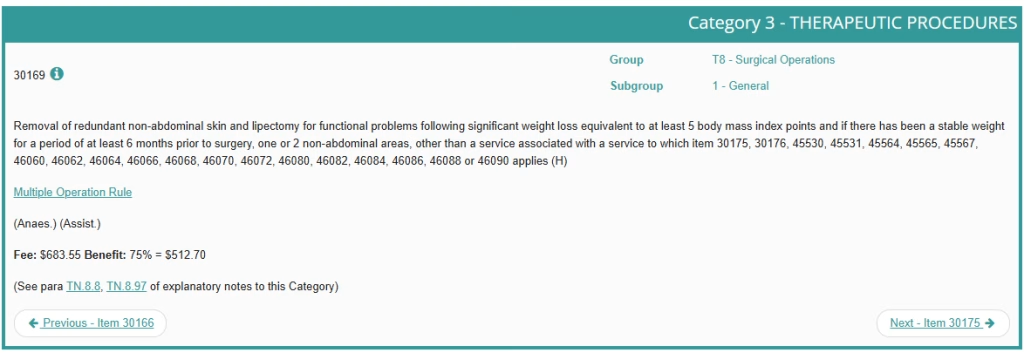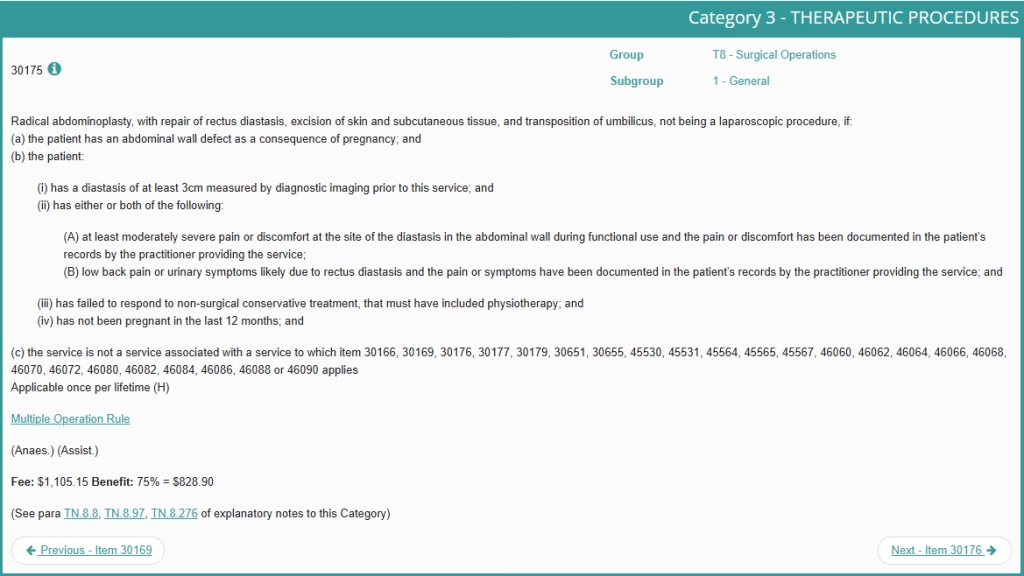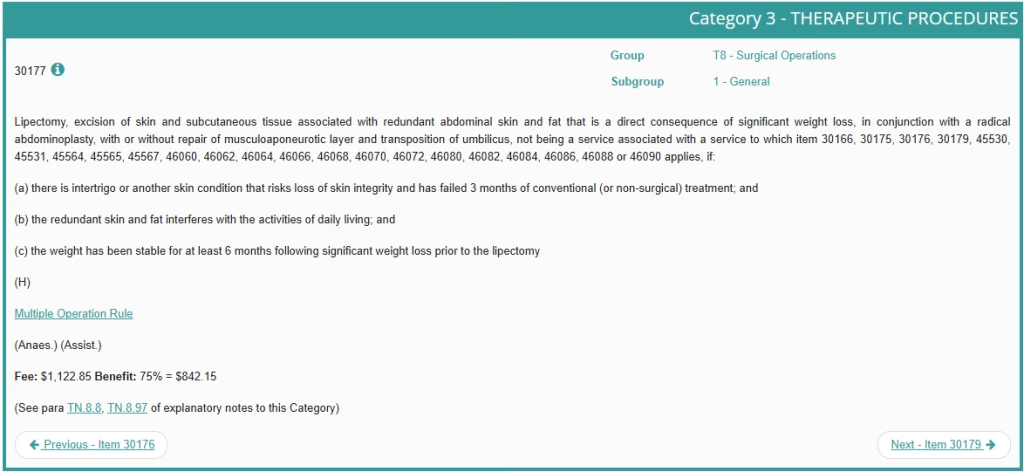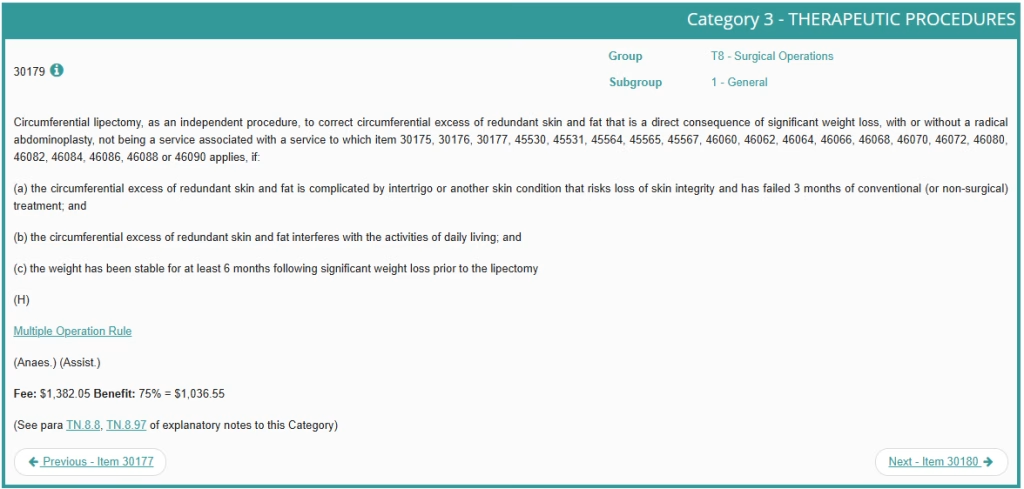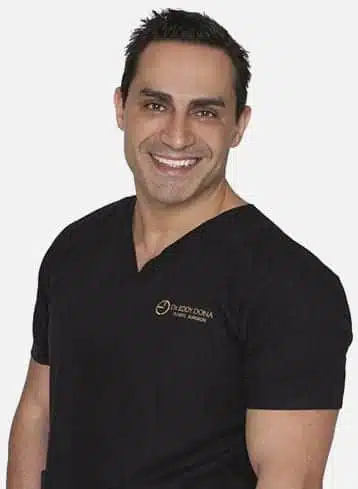Does Medicare Cover Tummy Tuck (Abdominoplasty) Surgery?
Mon 9th Jun 2025
We understand that your Tummy Tuck is a significant financial investment in your health and well-being. So, it makes sense to see if you qualify for any Medicare rebates to help ease the financial burden. While Medicare rebates exist, they are only available to those with medical conditions that meet Medicare’s strict criteria. Also, Medicare will only cover a small portion of the fee—you’ll still have a significant out-of-pocket fee to pay.
Here’s what you need to know.
KEY INFORMATION:
- Free Abdominoplasty is rarely available in the public health system and will have a long waiting list.
- Small Medicare rebates apply to some individuals requiring abdominal surgery for medical reasons that meet the strict criteria.
- Medicare does not cover abdominoplasty surgery if it’s purely for cosmetic reasons.
- Abdominoplasty with a skilled plastic surgeon in private practice warrants a substantial out-of-pocket fee—even if you are eligible for a Medicare and Private Health Insurance rebate.
UPDATE: Medicare Item Numbers have changed, effective from 1st July 2023.
- Item numbers 30165, 30168, 30171 and 30172 have been deleted.
- Item numbers 30166 and 30176 have been added.
- Item numbers for new combined surgeries are possible. 30166 (Lipectomy) can now be combined with 30169 (Arms/legs).
What expenses are involved in a Tummy Tuck procedure?
There are numerous expenses involved in a Tummy Tuck procedure. To determine how much it will cost you, please book an Initial Consultation with Dr Dona . At the end of your consultation, after discussing your concerns and having a comprehensive physical examination, Dr Dona’s clinic will provide you with an itemised plan outlining all expenses, so you know exactly how much you must pay.
Factors impacting the cost of your procedure include:
- Medicare eligibility
- Private Health Insurance status and coverage
- Surgeon’s fee
- Anaesthesia fees
- Hospital/surgical facility costs
- Prescriptions for medication
- Post-surgery garments
- Medical tests, such as ultrasounds
- Any costs associated with nonsurgical prior treatment, such as physiotherapy.
Who Qualifies For Medicare Rebates?
To qualify for a Medicare item number and rebate, your Tummy Tuck procedure must fall into one of two categories. One is for individuals requiring muscle repair after pregnancy, and the other is for individuals who have lost a lot of weight and typically suffer from excess skin problems. Within those categories, there are several item numbers available.
Below are the MBS (Medicare Benefits Schedule) item numbers that reimburse for different Tummy Tuck surgeries.
Item No 30169 (Removal of redundant non-abdominal skin and lipectomy)
SUMMARY: This item number applies to those with functional problems following significant weight loss equivalent to at least five body mass index points. It also applies to those who have maintained a stable weight for at least six months before surgery in one or two non-abdominal areas.
Item No 30175 (Abdominoplasty with muscle repair after pregnancy)
https://www9.health.gov.au/mbs/fullDisplay.cfm?type=item&q=30175&qt=ItemID
SUMMARY: Since July 2022, Medicare has introduced a new item number (30175) for women who experience postpartum rectus diastases (tummy muscle split).
Am I eligible?
Eligibility for this item number is as follows:
- Cause: The rectus diastases was caused by pregnancy
- Timing: The patient must have waited at least 12 months after childbirth before the procedure.
- Gap measurement: The gap between the abdominal muscles must be at least three centimetres.
- Symptoms: The individual must have documented pain or discomfort at the site and/or low back pain or urinary symptoms.
- Other treatment failed: The individual must have tried and failed to respond to nonsurgical treatment options such as physiotherapy. (Other examples of nonsurgical treatment may be symptomatic management with pain medication, lower back braces, lifestyle changes and exercise.)
Item No 30177 (Lipectomy, surgical removal of excess tissue that is a direct consequence of weight loss)
https://www9.health.gov.au/mbs/fullDisplay.cfm?type=item&q=30177&qt=ItemID
SUMMARY: This item number is for lipectomy, removal of excess skin and subcutaneous tissue associated with redundant abdominal skin and fat that is a direct consequence of significant weight loss, in conjunction with a radical abdominoplasty, with or without repair of the musculoaponeurotic layer and transposition of the umbilicus.
Item number 30177 caters to those with weight loss that meets the following criteria:
- There is intertrigo or another skin condition that risks the loss of skin integrity.
- The condition has failed three months of nonsurgical treatment.
- Redundant skin and fat interfere with daily living activities.
- The patient has maintained a stable weight for at least six months following significant weight loss before the lipectomy.
- The patient has a hernia, which can be documented in an ultrasound.
Item No 30179 (Circumferential lipectomy – as an independent procedure)
https://www9.health.gov.au/mbs/fullDisplay.cfm?type=item&qt=ItemID&q=30179
SUMMARY: To qualify, this must be an independent procedure, involving circumferential lipectomy to correct circumferential excess of redundant skin and fat, a direct consequence of significant weight loss. The item number applies if:
- There is intertrigo or another skin condition that risks the loss of skin integrity.
- The condition has failed three months of nonsurgical treatment.
- The redundant skin and fat interfere with daily living activities.
- The patient has had stable weight for at least six months following significant weight loss before the lipectomy.
FREQUENTLY ASKED QUESTIONS
What if I have Private Health Insurance?You need a Medicare item number to present to your Private Health Insurer for them to consider providing any cover. If you have an item number, and the right level of Private Health Insurance, then your health fund should cover all your private hospital costs. If none of the above item numbers apply to you, then no matter what level of Private Health Insurance you have, it will not cover you – and therefore you will have to pay or all your hospital costs.
What is a Tummy Tuck (Abdominoplasty)?
A Tummy Tuck (called Abdominoplasty) is a surgical procedure that reconstructs the abdominal wall. Surgery can result in improved abdominal shape, texture and tone with individuals often experiencing improved posture and muscle function.
Most patients have Tummy Tuck surgery for reconstructive reasons, not cosmetic ones. They may have experienced extreme weight loss or require surgery after pregnancy. In both instances, their abdominal skin and muscles have been severely stretched and/or damaged. This typically results in a loose tummy that can’t be tightened through exercise alone and cannot be improved by liposuction alone.
Can I have Abdominoplasty done in the public system?
Although Abdominoplasty is performed in the public system for free, it is rare and has exceedingly long waiting lists.
Can I use my super fund to pay for abdominoplasty surgery?
In some circumstances, you can access your superannuation for abdominoplasty surgery. To qualify, your surgery must be for medical reasons involving severe or chronic pain, such as pain and discomfort due to abdominal skinfolds left after pregnancy. Alternatively, you may have excess skin folds after weight loss that are causing considerable pain and discomfort.
To apply to have your superannuation released early, you can visit the ATO website. You’ll need super eligibility forms completed by your plastic surgeon and GP. They will also need to provide additional detailed information pertaining to your condition.
How do you know if you qualify for a Medicare Rebate?
The only way to know if you qualify for a Medicare rebate is to have an Initial Consultation with Dr Dona. You may qualify for a small Medicare rebate if your condition is deemed medical and not cosmetic. Your medical condition will either be a result of pregnancy, where you have experienced significant muscle separation (diastasis recti) or a result of severe weight loss, where excess skin and tissue are causing you considerable pain and discomfort or functional problems.
References
Australian Society of Plastic Surgeons: https://plasticsurgery.org.au/information-for-patients/abdominoplasty-with-muscle-repair-after-pregnancy/
Medicare Benefits Schedule: https://www9.health.gov.au/mbs/search.cfm
Health Direct – Abdominoplasty: https://www.healthdirect.gov.au/abdominoplasty
